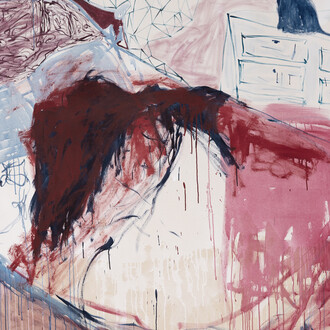YSP presents the first UK museum display of work by the highly acclaimed North American artist Daniel Arsham.
Four of Daniel Arsham’s bronze sculptures can be found outdoors in the 18th-century Formal Garden including Bronze extraterrestrial bicycle (2022), Bronze eroded bunny (large) (2022), and the three-metre tall Bronze eroded Venus of Arles (large) (2022) – Arsham’s retelling of the ancient marble statue of Aphrodite from the 1st century BCE.
As history progresses, all objects become antiquated and in some way, they all become ruins or relics, disused or buried. In 1000 years everything that we own will inevitably become one of those things. I don’t particularly see that as having an apocalyptic quality – it’s sort of just the march of time moving on.
(Daniel Arsham)
Arsham’s sculptures appear as archaeological remnants of our time that he describes as ‘future relics’. His artistic practice is underpinned by the formative childhood experience of surviving Hurricane Andrew, which struck the Southern United States in 1992 and destroyed his family home and everything around it. Reflecting this, Arsham’s works are partially decayed and explore regeneration represented by real crystals that have been cast in bronze. The inclusion of the crystal forms alludes to alchemical change (the transformation of one substance into another), growth, and progression. A visit to Easter Island in 2011 where he encountered a palaeontology research expedition deepened Arsham’s interest in archaeology and continues to inform his practice.
The artist was recently given access to the original foundry moulds of some of France’s most iconic classical sculptures displayed in the Louvre, including a 3.9-metre-tall female figure that was carved around 50 BCE. The statue was unearthed in the 15th century and for the last 500 or so years she has been thought of as Melpomene, the Greek muse of tragedy. From the mould of this sculpture Arsham created Unearthed bronze eroded Melpomene (2021), which in this landscape connects the past with the present. The ground in which YSP stands has been inhabited since at least the 11th century; here, Arsham’s sculptures resonate with the layers of human activity that have shaped and will continue to shape the environment.
Alongside sculptures drawn from antiquity are works that use imagery from recent history and pop culture.
I first visited Yorkshire Sculpture Park a couple of years ago and was struck by the way sculptures would connect with the landscape there: the rolling hills, the changing seasons and the interaction of the work with the natural light, lakes and surroundings. I immediately started thinking about a project I could embark on in the landscape that would allow my work to take advantage of the unique context presented there. The works I’m showing vary in scale, some are presented in an open garden and others are concealed or hidden within woodland, for viewers to discover.
(Daniel Arsham)
Daniel Arsham: Relics in the landscape is made possible by generous support from Perrotin.













